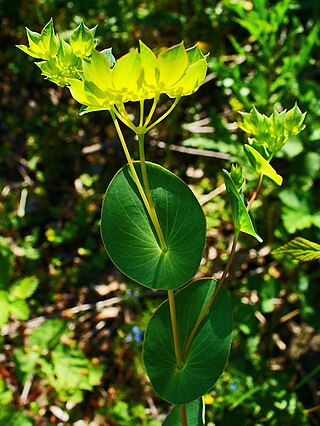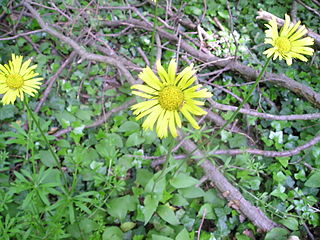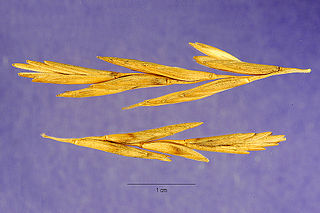
Colchicum is a genus of perennial flowering plants containing around 160 species which grow from bulb-like corms. It is a member of the botanical family Colchicaceae, and is native to West Asia, Europe, parts of the Mediterranean coast, down the East African coast to South Africa and the Western Cape. In this genus, the ovary of the flower is underground. As a consequence, the styles are extremely long in proportion, often more than 10 cm (4 in). All species in the genus are toxic.

Heracleum is a genus of biennial and perennial herbs in the carrot family Apiaceae. They are found throughout the temperate northern hemisphere and in high mountains as far south as Ethiopia. Common names for the genus or its species include hogweed and cow parsnip.

Verbascum is a genus of over 450 species of flowering plants, common name mullein, in the figwort family Scrophulariaceae. They are native to Europe and Asia, with the highest species diversity in the Mediterranean.

Anthemis is a genus of aromatic flowering plants in the family Asteraceae, closely related to Chamaemelum, and like that genus, known by the common name chamomile; some species are also called dog-fennel or mayweed. Anthemis are native to the Mediterranean region and southwest Asia east to Iran. A number of species have also become naturalized in the United Kingdom and other parts of the world.

Inula is a genus of about 80 species of flowering plants in the family Asteraceae, native to Europe, Asia and Africa.

Petrorhagia is a small genus of annual and perennial plants of the family Caryophyllaceae, mostly native to the Mediterranean region. It is low-growing with wiry stems and narrow, grass-like leaves. The flowers are small, in clusters similar to members of the genus Dianthus, in pink, lilac, or white. Petrorhagia saxifraga is the tunic flower or coat flower, similar to baby's breath, but shorter, and used in rock gardens.

Bupleurum is a large genus of annual or perennial herbs or woody shrubs, with about 190 species, belonging to the family Apiaceae. The full size of its species may vary between a few cm to up to 3 m high. Their compound umbels of small flowers are adorned with bracteoles that are sometimes large and may play a role in attracting pollinators. Rare among the Apiaceae are the simple leaves, bracts, and bracteoles. The genus is almost exclusively native in the Old World Northern Hemisphere, with one species native to North America and one species native to southern Africa.

Asperula, commonly known as woodruff, is a genus of flowering plants in the family Rubiaceae. It contains 194 species and has a wide distribution area from Europe, northern Africa, temperate and subtropical Asia to Australasia.

Doronicum is a genus of flowering plants in the sunflower family, known as leopard's bane. They are all herbaceous perennials native to Europe, southwest Asia and Siberia. They produce yellow, daisy-like flowerheads in spring and summer.

Chaerophyllum is a genus of flowering plant in the family Apiaceae, with 35 species native to Europe, Asia, North America, and northern Africa. It includes the cultivated root vegetable Chaerophyllum bulbosum.

Filago is a genus of plants in the sunflower family, native from Europe and northern Africa to Mongolia, Nepal, and Macaronesia. They are sometimes called cottonroses or cudweeds.

Omalotheca is a genus of flowering plants in the daisy family. It is commonly known as arctic cudweed.

Seseli is a genus of herbaceous perennial plants in the family Apiaceae. They are sometimes woody at base with a conic taproot. Leaf blades are 1–3-pinnate or pinnately decompound. Umbels are compound, with bracts few or absent. Petals are white or yellow, and the fruit ovoid or ellipsoid.

Opopanax is a genus of plants in the family Apiaceae.

Thinopyrum is a genus of Eurasian and African plants in the grass family.

Tordylium is a genus of flowering plants in the carrot family (Apiaceae). Members of the genus are known as hartworts.

Asperula aristata is a deciduous species of perennial groundcover, and a flowering plant in the family Rubiaceae, known as woodruff. It is native to Morocco, Libya, Algeria, Tunisia, Azerbaijan, Georgia, Armenia, Greece, Bulgaria, Albania, Serbia, North Macedonia, Croatia, Italy, Austria, Switzerland, France, Spain, and Portugal.

Ricotia is a genus of flowering plants in the family Brassicaceae, found in the Aegean islands, Crete, the Levant, the Sinai peninsula, Turkey, and the Transcaucasus. They appear to have arisen in Anatolia, to which five species are endemic.
Beta nana, the dwarf beet, is a species of flowering plant in the family Amaranthaceae, native to the mountains of central and southern Greece. Its resistance to cold has potential in efforts to improve the sugar beet. The plants are small, with rosettes of leaves typically no more than 10 cm across. Flowers are single. Fruit is a hard monogerm seed that contains a single embryo.


















